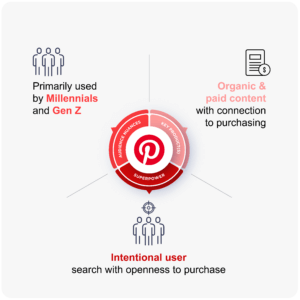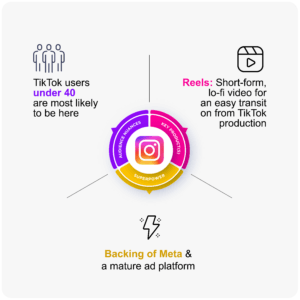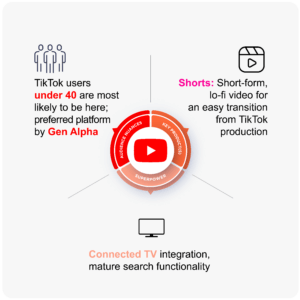
How Marketers Should Approach TikTok in 2025
The one thing that can be counted on in social media is that it’s always changing. It’s what keeps many of us excited about working in the social space and it keeps us on our toes. With a potential TikTok ban looming in the U.S., being flexible and nimble when it comes to social media planning for 2025 will be key.
TikTok briefly became unavailable in the U.S. in accordance with a law banning the platform in January. When President Trump took office, he signed an executive order that gave TikTok a lifeline for another 75 days, bringing the app back online while the new administration works through possible solutions. That has given TikTok until April 5th, or it could once again go dark in the U.S. With uncertainty around what 2025 may look like in the U.S. social media landscape, how should brands and marketers be preparing?
The best advice is to plan for two scenarios. There’s of course the scenario where TikTok is able to remain active in the U.S., assuming it finds a partner that’s acceptable to all parties. That scenario would keep most brands in a business-as-usual flow with TikTok where it would remain a popular and beloved platform by its users. The other scenario to plan for is one in which TikTok is no longer available in the U.S.
There are several things to consider with the uncertainty around TikTok:
1. TikTok Behaviors Are Here to Stay So Don’t Panic
If you’re a brand that invested in building a presence on TikTok, don’t worry. The lessons learned in creating content successfully for the platform will carry over to others where similar short-form, lo-fi formats are also winning the day. The behaviors and preferences of TikTok’s audiences also aren’t going anywhere. TikTok fundamentally changed social media, giving rise to a frictionless experience where users can discover and be entertained without ever having to friend someone, mute a topic or curate a list of accounts to follow. This approach has been integrated in various forms to Western-created social platforms. For brands, this means that the ability to reach audiences — even organically — is possible on other platforms. It takes the right type of content just as it did on TikTok.
2. Consider Other Platforms
TikTok users will go elsewhere should the ban take effect, and brands should be ready to develop a presence on other social platforms or to shift additional resources there. Which platforms should brands be ready for? It may vary based on audience and how each platform may best meet business objectives.




3. Optimize Content for Social Search
Another behavior TikTok helped shape was the use of social platforms for search versus traditional platforms like Google. Nearly half of Gen Z and 35% of Millennials turn to social platforms first when searching for information, according to a recent Forbes study. For many, that go-to informational social platform has been TikTok, but brands should expect this behavior to continue elsewhere. Developing evergreen content and optimizing copy and tags for search on other platforms like Instagram and YouTube would be recommended.
4. Think Globally
For brands with a global presence, even if TikTok goes away in the U.S., it may still be a viable platform in other markets. This should be vetted strategically through the lens of the market and, if a presence is recommended to continue, it will be important to ensure TikTok management is set up in a non-U.S. location.
5. Develop Relatable Content Around the Moment
Brands that have a highly engaged audience on TikTok may benefit from leaning into the moment, should a ban happen, and create content that demonstrates an understanding of the collective loss some will feel with a TikTok departure. We already saw this taking place ahead of the original date for a ban. The content could be shared on TikTok while it’s still available in the U.S. and it would be an opportunity to promote the brand’s presence on other social platforms.
6. Be Flexible with Paid Media
With uncertainty around the future of TikTok beyond early April, it will be important for marketers to bake flexibility in to paid media plans. Running paid media on TikTok even ahead of a potential ban is largely still recommended for most brands given that U.S. audiences are still there. But it will be important to have a backup plan on how paid media would be reallocated in April and beyond just in case a pivot is needed.
Common Questions
Is TikTok getting banned in the U.S. in 2025?
While a ban briefly took effect in the U.S. for about 12 hours in January, TikTok became available after an executive order halted the ban for 75 days.
When would a ban take effect?
If a solution cannot be reached that satisfies U.S. requirements and TikTok’s owners, a ban would take effect on April 5, 2025.
Why is there a potential TikTok ban in the U.S.?
In April 2024, President Biden signed a law that gave TikTok’s Chinese parent company, ByteDance, roughly nine months to divest, in response to security concerns that TikTok contests.
Who would buy or partner with TikTok?
Several U.S. tech companies have expressed interest in buying TikTok, including Microsoft, Amazon and Oracle, in addition to some individual investors.
Would a TikTok ban in the U.S. affect CapCut?
Yes. Because CapCut is owned by ByteDance, a TikTok ban would also make CapCut unavailable in the U.S.
Should I promote my brand’s other social channels on TikTok?
Yes! It’s recommended to let your audience know of other social channels where they can find your brand.
Is TikTok available in app stores?
TikTok became unavailable in the Apple and Google app stores on January 18th but returned on February 13th.
This is not an advertisement, and solely reflects the views and opinions of the author. This website and its commentaries are not designed to provide legal or other advice and you should not take, or refrain from taking, action based on its content. Additionally, unless otherwise stated, neither 9Rooftops nor the author is involved in, or responsible for, the marketing or promotional efforts of the individuals or entities discussed.

